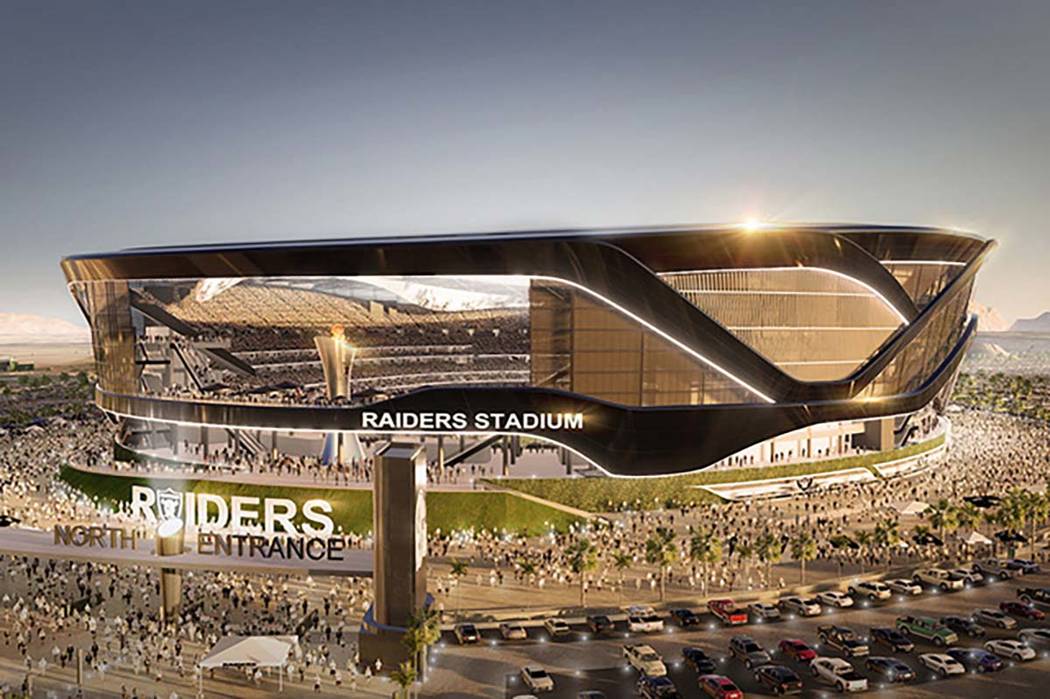Exact cost of Raiders’ Las Vegas stadium still unknown

The Oakland Raiders and local officials are no further along than they were a year ago in locking down a key aspect of the Las Vegas stadium project: how much it will cost.
It’s been widely reported that the domed stadium, scheduled to open in June 2020 just northwest of Interstate 15 and Russell Road, would cost $1.9 billion. But that figure remains nothing more than an estimate for the total cost of the stadium and a practice facility for the NFL team, which earlier this year received league approval to move to Las Vegas. The reality is the projects’ total cost could be more or less than that amount.
The Raiders confirmed in March that they had negotiated a loan with Bank of America for the stadium, a key element of approvals by the Las Vegas Stadium Authority and NFL owners for a conditional lease agreement. But the team never shared a dollar amount or whether a revolving credit facility is involved in the financing.
Bank of America stepped in when Las Vegas Sands Chairman and CEO Sheldon Adelson, who said he would put $650 million of his personal fortune into the project, exited his partnership with the Raiders in January. Bank of America has never said whether it would cover that entire $650 million hole. And the public, which is funding $750 million of the stadium’s construction costs via an increase in Clark County’s hotel room tax, has learned little about the arrangement between the bank and the team.
Little more public information
Stadium Authority Board Chairman Steve Hill last week confirmed that the public won’t get much more information about the details of the loan, citing confidentiality granted to the bank and the team through Senate Bill 1, the legislation that increased the room tax and established the stadium’s financing plan.
“A big part of the information that the board will get will be confidential,” Hill told reporters after Thursday’s board meeting. “The Raiders’ financial situation is not going to be a public document, so we’ll get a framework for that at a board meeting and individual board members will get a more thorough briefing outside of the public meeting.”
Hill explained that board members would be briefed individually or in small groups and would not deliberate on decisions related to the financial package to operate within the bounds of the state’s open meeting law. He said the total cost of the stadium eventually would be disclosed, but not the details of the Raiders’ financing arrangements.
Jeremy Aguero of Las Vegas-based Applied Analysis, which serves as the staff for the authority board, said a public discussion would occur on whether the Raiders would be financially capable of delivering on their commitments, but that won’t include specific financial information, particularly if the team deems it proprietary information that could hurt them competitively.
“I’m not going to opine or guess on what type of information is going to be provided and in what fashion or level of specificity, but there is a budget required for the project and there is a requirement the committee makes a finding of financial capability,” Aguero said. “Exactly how all that plays out will be at the discretion of the committee.”
The estimated $1.9 billion price on the stadium includes $100 million to build a practice facility and headquarters for the team. The team has not identified a site for that facility or any details about its construction, but several local governments have expressed interest in having it within their boundaries.
The bill for the projects could come in under that figure if the team opts to spend less initially and add improvements over the 30-year duration of the lease agreement, or more if there are cost overruns. Some local construction experts say the cost of labor may be higher than expected because of the numerous projects in Southern Nevada competing for laborers and craftsmen.
The Las Vegas Convention and Visitors Authority, for example, is anticipating higher labor costs for its $1.4 billion convention center expansion and remodeling project and is budgeting $114.9 million in contingency funds to cover what the LVCVA’s contracted building representative, Terry Miller of Cordell Corp., called “construction industry compression.” Cordell was backed up by the seven-member Oversight Panel for Convention Facilities in Clark County, which is monitoring the project.
Most overruns obligation of developer
Under Senate Bill 1, the stadium developer would be responsible for any construction cost overruns with one exception: if the overrun is caused by a change mandated by the stadium authority after the execution of the development agreement. The authority wouldn’t be responsible for cost overruns if it mandates changes required by county building and safety codes.
The specifics of the Raiders’ contract with Minneapolis-based Mortenson Construction also is unclear.
Raiders President Marc Badain acknowledged in May that Mortenson, the company that recently built U.S. Bank Stadium for the Minnesota Vikings, was contracted for the job and that company has a working relationship with Henderson-based McCarthy Building Cos. Inc.
The Raiders have not indicated whether they put the job out to bid or selected Mortenson based on its track record. U.S. Bank Stadium, like the proposed Las Vegas stadium, has a rigid roof structure. The contractor delivered that project ahead of schedule.
The Raiders and the stadium authority expect the Las Vegas project to be on a tight timeline. A stadium normally takes 32 to 40 months to build. The Las Vegas stadium is expected to be complete within 30 months. Groundbreaking is expected late this year or early next year.
The Raiders did not respond to email inquiries about details of the project and its financing, and the team has told Mortenson, McCarthy and architect David Manica not to respond to media inquiries.
The Review-Journal is owned by the family of Las Vegas Sands Corp. Chairman and CEO Sheldon Adelson.
Contact Richard N. Velotta at rvelotta@reviewjournal.com or 702-477-3893. Follow @RickVelotta on Twitter.